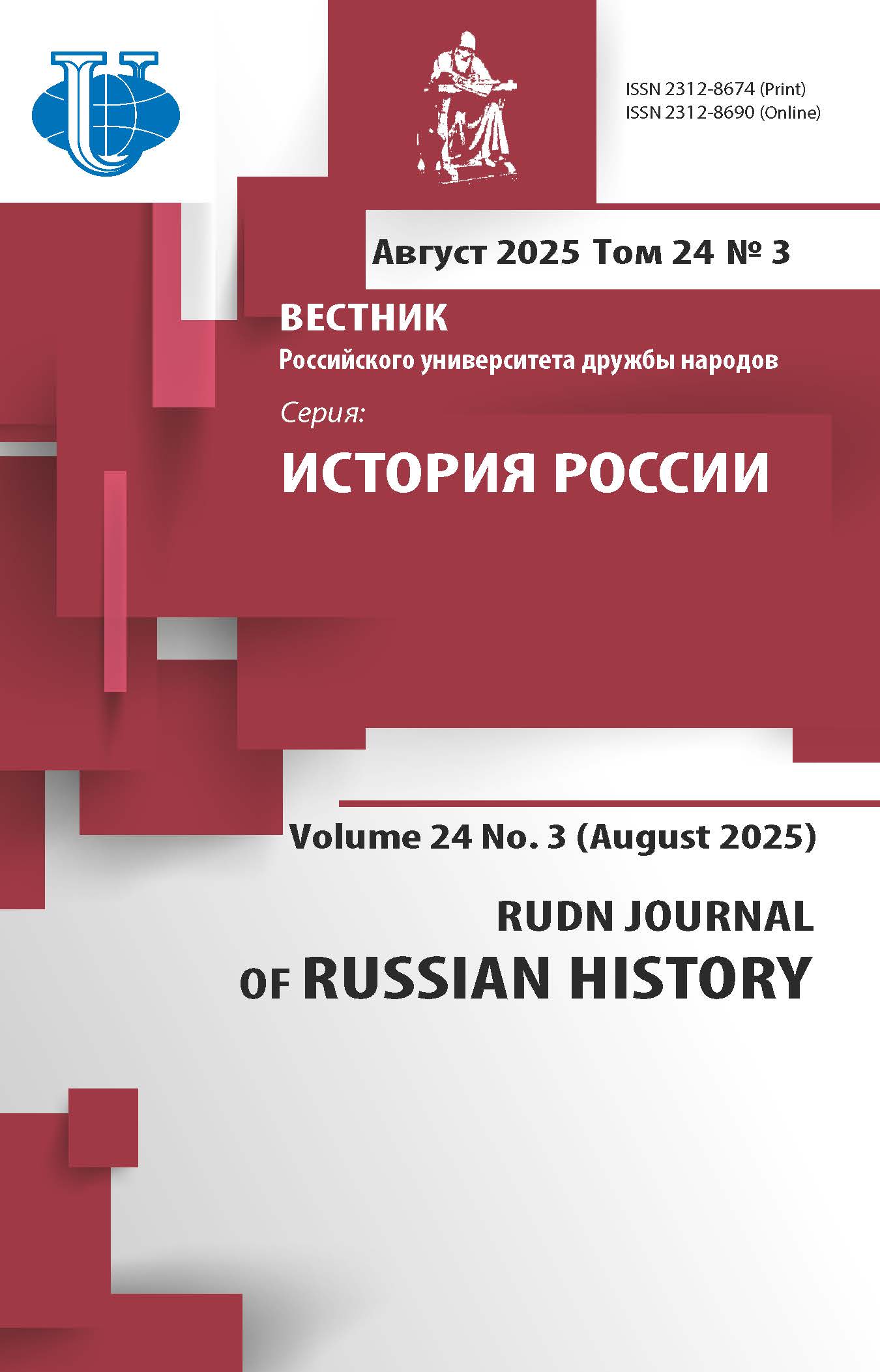ОТ СОЛДАТСКОЙ БЕЗГРАМОТНОСТИ К РЕВОЛЮЦИЯМ: НИЗКИЙ ОБРАЗОВАТЕЛЬНЫЙ УРОВЕНЬ НИЖНИХ ЧИНОВ КАК ОДНА ИЗ ПРИЧИН РУССКОЙ РЕВОЛЮЦИИ 1917 Г.
- Авторы: Авилов Р.С.1,2
-
Учреждения:
- Институт истории, археологии и этнографии народов Дальнего Востока ДВО РАН
- Дальневосточный федеральный университет
- Выпуск: Том 16, № 1 (2017)
- Страницы: 7-19
- Раздел: К 100-ЛЕТИЮ РЕВОЛЮЦИИ 1917 ГОДА В РОССИИ
- URL: https://journals.rudn.ru/russian-history/article/view/15757
- DOI: https://doi.org/10.22363/2312-8674-2017-16-1-7-19
- ID: 15757
Цитировать
Полный текст
Аннотация
В статье на основе архивных материалов исследуется наметившееся в годы Первой мировой войны влияние падения уровня военной грамотности нижних чинов запасных частей и дружин Государственного ополчения на их восприимчивость к революционной агитации. Использование документов текущего делопроизводства Приамурского военного округа дало возможность выявить объективные и субъективные причины снижения качества обучения и боевой подготовки солдат в 1915-1917 гг. Установлено, что падение образовательного уровня и боевой подготовки войск было одним из важнейших факто-ров успеха Российской революции 1917 г.
Ключевые слова
Об авторах
Роман Сергеевич Авилов
Институт истории, археологии и этнографии народов Дальнего Востока ДВО РАН; Дальневосточный федеральный университет
Автор, ответственный за переписку.
Email: avilov-1987@mail.ru
690001, Россия, Владивосток, ул. Пушкинская, 89; 690095, Россия, Владивосток, ул. Алеутская, 65-б
Список литературы
- Государственный архив Хабаровского края. Научно-справочная библиотека (ГАХК. НСБ). Ед. хр. 1529.
- ГАХК. НСБ. Ед. хр. 1530.
- ГАХК. НСБ. Ед. хр. 1531.
- ГАХК. НСБ. Ед. хр. 2298.
- Российский государственный исторический архив Дальнего Востока (РГИА ДВ). Ф. 702. Оп. 5. Д. 337.
- Айрапетов О. Р. Участие Российской империи в Первой мировой войне (1914-1917). Т. 1-2. М.: ИД КДУ, 2014.
- Айрапетов О. Р. Участие Российской империи в Первой мировой войне (1914-1917). Т. 3-4. М.: Кучково поле; Военная книга, 2015.
- Булдаков В. П. Первая мировая война : шанс на модернизацию России // Вестник Тверского государственного университета. Серия История России. 2014. № 1. С. 4-23.
- Головин Н. Н. Военные усилия России в Мировой войне. М.: Кучково поле , 2001. 440 с.
- Гулин А. О. Основные тенденции современной историографии Первой мировой вой ны // Вестник КГУ им. Н.А. Некрасова. 2012. № 5. С. 162-166.
- Авилов Р.С. Вестник РУДН. Серия: История России. 2017. Т. 16. № 1. С. 7-19.
- Козенко Б. Д. Отечественная историография Первой мировой войны // Новая и но вейшая история. 2001. № 3. С. 3-27.
- Мировые войны ХХ в.: В 4 кн. М.: Наука, 2002. Кн. 1. 686 с.
- Булдаков В. П. Революция как проблема Российской истории // Вопросы философии. 2003. № 1. С. 53-64.
- Будник Г. А. Новые подходы к изучению Революции 1917 г. в России // Вестник ИГЭУ. 2008. Вып. 1. С. 1-5.
- Макаренко П. В. Германский фактор в Октябрьской революции 1917 г. // Вопросы истории. 2008. № 5. С. 30-45.
- Российские революции 90 лет спустя. «Круглые столы» в Институте Российской истории РАН // Отечественная история. 2008. № 6. С. 167-211.
- Фельдман М. А. Была ли Октябрьская революция 1917 г. пролетарской ? ( Проблемы истории и историографии) // Общественные науки и современность. 2012. № 5. С. 112-120.
- Авилов Р. С., Аюшин Н. Б., Калинин В. И. Владивостокская крепость : войска , фортификация, события, люди. Владивосток: Дальнаука, 2013-2016. Ч. I-IV.
- Марков О. Д. Русская армия 1914-1917 гг. СПб.: Галлея Принт , 2001. 160 с.
- Оськин М. В. Государственное ополчение в период Первой мировой войны // Вопросы истории. 2013. № 6. С. 142-152.
- Иконникова Т. Я. Ополченские дружины Приамурского военного округа в 1914-1917 гг. // Военно-исторический журнал. 2009. № 2. С. 35-40.
- Керсновский А. А. История русской армии. Т. 3-4. М.: Голос , 1994.
- Приказ войскам Приамурского военного округа № 765 от 25 октября 1914 г. // Государственный архив Хабаровского края (ГАХК). Научно-справочная библиотека (НСБ). Ед. хр. 1530.
- Приказ войскам Приамурского военного округа № 839 от 24 ноября 1914 г. // ГАХК. НСБ. Ед. хр. 1530.
- Приказ войскам Приамурского военного округа № 899 от 15 декабря 1914 г. // ГАХК. НСБ. Ед. хр. 1531.
- Приказ войскам Приамурского военного округа № 921 от 24 декабря 1914 г. // ГАХК. НСБ. Ед. хр. 1530.
- Приказ войскам Приамурского военного округа № 928 от 31 декабря 1914 г. // ГАХК. НСБ. Ед. хр. 1530.
- Приказ войскам Приамурского военного округа № 17 от 20 января 1915 г. // ГАХК. НСБ. Ед. хр. 1529.
- Приказ войскам Приамурского военного округа № 168 от 17 апреля 1915 г. // ГАХК. НСБ. Ед. хр. 1529.
- Российский государственный исторический архив Дальнего Востока (РГИА ДВ). Ф. 702. Оп. 5. Д. 337. Лл. 7-12.
- Приказ войскам Приамурского военного округа № 911 от 20 декабря 1914 г. // ГАХК. НСБ. Ед. хр. 1531.
- Приказ войскам Приамурского военного округа № 711 от 30 декабря 1915 г. // ГАХК. НСБ. Ед. хр. 1529.
- Приказ войскам Приамурского военного округа № 36 от 26 января 1915 г. // ГАХК. НСБ. Ед. хр. 1529.
- Приказ войскам Приамурского военного округа № 202 от 30 апреля 1915 г. // ГАХК. НСБ. Ед. хр. 1529.
- Приказ войскам Приамурского военного округа № 592 от 4 ноября 1915 г. // ГАХК. НСБ. Ед. хр. 1529.
- Приложение к Приказу войскам Приамурского военного округа № 467 от 22 сентября 1916 г. // ГАХК. НСБ. Ед. хр. 2298.
- Приказ войскам Приамурского военного округа № 666 от 10 декабря 1915 г. // ГАХК. НСБ. Ед. хр. 1529.
- Приложение к Приказу войскам Приамурского военного округа № 467 от 22 сентября 1916 г. // ГАХК. НСБ. Ед. хр. 2298
- Приказ войскам Приамурского военного округа № 579 от 30 ноября 1916 г. // ГАХК. НСБ. Ед. хр. 2298
Дополнительные файлы















